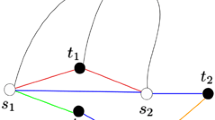Abstract
With the birth of DNA computing, Paun et al. proposed an elegant algorithm to this problem based on the sticky model proposed by Roweis. However, the drawback of this algorithm is that the “exponential curse” is hard to overcome, and therefore its application to large instance is limited. In this s paper, we present a DNA based evolutionary algorithm to solve this problem, which takes advantage of both the massive parallelism and the evolution strategy by traditional EAs. The fitness of individuals is defined as the negative value of their length. Both the crossover and mutation can be implemented in a reshuffle process respectively. We also present a short discussion about population size, mutation probability, crossover probability, and genetic operations over multiple points. In the end, we also present some problems needed to be further considered in the future.
Preview
Unable to display preview. Download preview PDF.
Similar content being viewed by others
References
Adleman, L.: Molecular computation of solution to combinatorial problems. Science 266, 1021–1024 (1994)
Hartmanis, J.: On the weight of computations. Bulletin of the European Association for Theoretical Computer Science 55, 136–138 (1995)
Ogihara, M.: Breadth first search 3-SAT algorithms for DNA computers. Technical Report TR 629, University of Rochester, Department of Computer Science, Rochester (1996)
Bänk, T., Kok, J., Rozenberg, G.: Cross-Fertilization between Evolutionary Computation and DNA-based Computing. In: Proceedings of the IEEE Congress on Evolutionary Computing, pp. 980–987 (1999)
Chen, J., Wood, D.H.: Computation with Biomolecules. PNAS 97, 1328–1330 (2000)
Deaton, R., Murphy, R.C., Rose, J.A., Garzon, M., Franceschetti, D.R., Stevens, S.E.: A DNA based Implementation of an Evolutionary Search for Good Encodings for DNA Computation. In: Proceedings of the IEEE International Conference on Evolutionary Computation, pp. 267–272 (1997)
Wood, D., Bi, H., Kimbrough, S.O., Wu, D., Chen, J.: DNA Starts to Learn Poker. In: Proceedings of the 7th International Meeting on DNA-based Computers, pp. 23–32 (2001)
Rose, J.A., Hagiya, M., Deaton, R., Suyama, A.: A DNA-based in vitro Genetic Program. Journal of Biological Physics 28, 493–498 (2002)
Paun, G., Rozenberg, G., Salomaa, A.: DNA computing: New Computing Paradigms. Springer, Heidelberg (1998)
Michalewicz, Z.: Genetic Algorithms + Data Structures = Evolution Programs, 3rd edn. Springer, Heidelberg (1996)
Dove, A.: From bits to bases: Computing with DNA. Nature Biotechnology 16, 830–832 (1998)
Pool, R.: Forget silicon, try DNA. New Scientist. 151, 26–31 (1996)
Stemmer, W.P.C.: The evolution of molecular computation. Science 270, 1510–1518 (1995)
Head, T., Kaolan, P.D., Bladergroen, R.R.: Computing with DNA by operating on plasmids. Biosystem 57, 87–93 (2000)
Lipton, R.J.: DNA Solution of Hard Computation Problems. Science 268, 542–545 (1995)
Roweis, S., Winfree, E., Burgoyne, R., Chelyapov, N., Goodman, M., Rothemund, P., Adleman: A sticker based architecture for DNA computation. Journal Computational Biology 5, 615–629 (1998)
Wood, D., Chen, J.: Physical Separation of DNA According to Royal Road Fitness. In: Proceedings of The IEEE Conference on Evolutionary Computation, Dantsin, Voronkov (1998)
Chen, J., Antipov, E., Lemieux, B., Cedeno, W., Wood, D.H.: A Design for DNA Computation of the OneMax Problem. Soft Computing 5, 19–24 (2001)
Bäck, T., Kok, J.N., Rozenberg, G.: Evolutionary computation as a paradigm for DNA-based computing. Natural Computing Series, pp. 15–40. Springer, Heidelberg (2003)
Nielsen, P., Egholm, M., Berg, R., Buchardt, O.: Peptide nucleic acid (PNA). Nucleic Acids Research 21, 197–200 (1992)
Author information
Authors and Affiliations
Editor information
Editors and Affiliations
Rights and permissions
Copyright information
© 2005 Springer-Verlag Berlin Heidelberg
About this paper
Cite this paper
Liu, W., Zhu, X., Xu, G., Zhang, Q., Gao, L. (2005). A DNA Based Evolutionary Algorithm for the Minimal Set Cover Problem. In: Huang, DS., Zhang, XP., Huang, GB. (eds) Advances in Intelligent Computing. ICIC 2005. Lecture Notes in Computer Science, vol 3645. Springer, Berlin, Heidelberg. https://doi.org/10.1007/11538356_9
Download citation
DOI: https://doi.org/10.1007/11538356_9
Publisher Name: Springer, Berlin, Heidelberg
Print ISBN: 978-3-540-28227-3
Online ISBN: 978-3-540-31907-8
eBook Packages: Computer ScienceComputer Science (R0)




